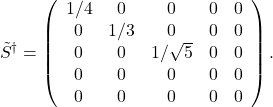Pseudo-inverse of a 4×5 matrix via its SVD
Returning to this example, the pseudo-inverse of the matrix

Can be computed via an SVD: ![]() , with
, with

as follows.
We first invert ![]() , simply “inverting what can be inverted” and leaving zero values alone. We get
, simply “inverting what can be inverted” and leaving zero values alone. We get

Then the pseudo-inverse is obtained by exchanging the roles of ![]() and
and ![]() in the SVD:
in the SVD:

See also: This example.
